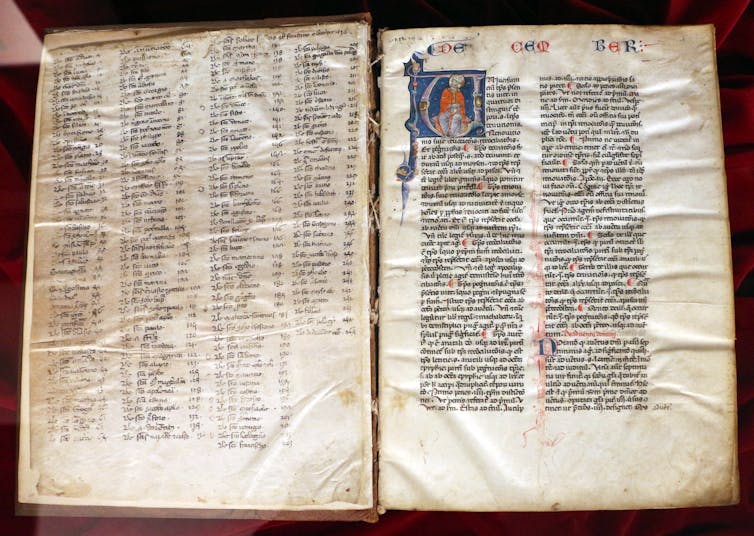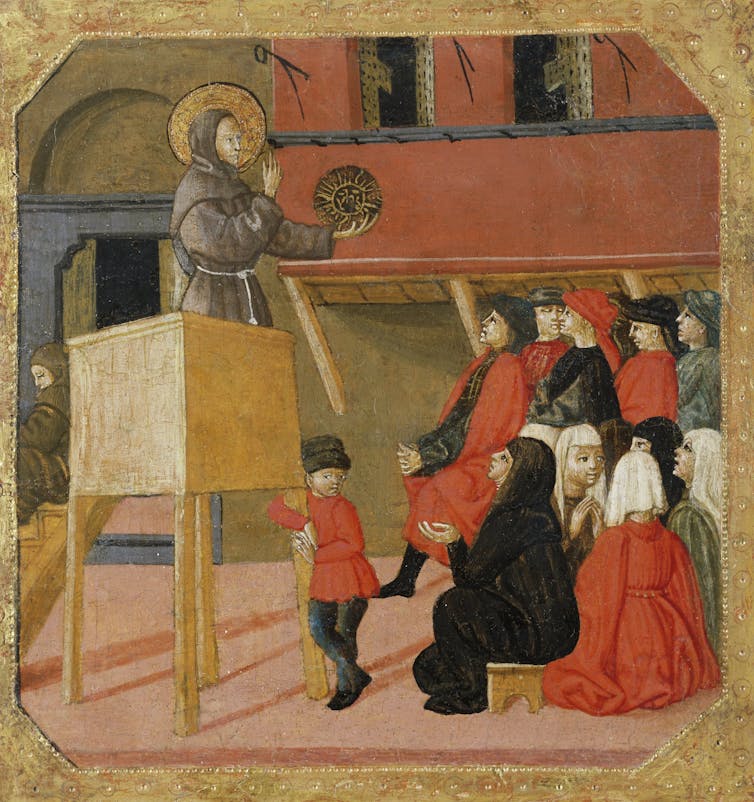
There is an obscure medieval legend that says once upon a time in Bethlehem, a child was born whose holiness was so great it required the slaughter of all the “sodomites” in the world.
Sodomites, the legend says, are so impure God did not want to share His humanity with them. So, He killed them all before He became human.
Clearly, there was no divine annihilation of sodomites on the first Christmas. Nonetheless, this curious example of medieval “fake news” is important because of what it represents.
The story combines ridiculous assertions and pious hatred in a manner familiar to many queer people today. What a medieval theologian meant by “sodomite” is not the same thing as what we mean today by “homosexual”. Yet, religious condemnations of “sodomy” are all too often applied to contemporary LGBTQ+ people.
A false legend
The medieval authorities who cited the legend believed it was fact. Their faith in the story rested on its supposed origins in the writing of Saints Jerome and Augustine, as explained by James of Voragine (c. 1230–1298) in his famous collection of saints’ lives called the Golden Legend.

James of Voragine wrote that Jerome and Augustine spoke of how “even the sodomites gave witness by being exterminated wherever they were” on Christ’s birth, because God hesitated to become incarnate while this vice existed in human nature.
The sudden death of all the world’s sodomites, of course, did not happen on the first Christmas. What is more, Jerome and Augustine never actually claimed it did. People who have looked in their works for the legend’s origins have found nothing.

Every part of the legend is false.
As far as I can tell, the story began in the classroom of Stephen Langton (c. 1150–1228) in Paris.
Langton was an intellectual who became the Archbishop of Canterbury and famously played a role in the events leading up to England’s Magna Carta.
Before all that, Langton in a lecture repeated a rumour he had heard about another great Parisian teacher, Peter the Chanter. He had heard Peter the Chanter had said he had read Jerome and Augustine who had said the world’s sodomites had died on the first Christmas.
Langton admitted he could not find where Augustine had made this claim.
Langton’s many students – who became some of the most influential and powerful men in history – repeated the story anyway. It conveyed what they wanted to be true. We can find it in saints’ lives, sermons, devotional works, compendiums of theology, and inquisitorial handbooks from the 13th to the 16th centuries and beyond.
Read more: What does the Bible say about homosexuality? For starters, Jesus wasn't a homophobe
A useful legend
Saints and theologians used the legend to solve apparent problems.
The great Italian preacher Bernardino of Siena (1380–1444) turned to the Christmas slaughter of the sodomites to explain why it was Jesus never mentioned sodomy, instead focusing on other vices like hypocrisy.

Bernardino – one of the most influential preachers in 15th-century Italy – especially detested sodomy, as well as witches and Jews. In a sermon preached at Florence in 1425, Bernardino explained Jesus did not address sodomy because there were no sodomites.
He “quoted” Jerome’s claim that all the sodomites in the entire universe died at Jesus’ birth, and said during Jesus’ ministry the practice had not re-emerged because of the fresh terror of God’s massacre. The saint urged the authorities of his day to follow God’s example and suggested the local sodomites be thrown into fires in the street.
The 15th-century Spanish inquisitorial handbook, the Repertorium inquisitorum, used the legend, along with the story of Sodom and Gomorrah, to justify the punishment of sodomy.
A continuing legend
Medieval thinkers’ ideas regarding sexual morality are still with us.
They especially endure in the connection between “sodomy” and modern homosexuality in some religious traditions. In official Catholic speech during the last century, as the theologian Mark Jordan has summarised:
‘Homosexuality’ took the place of ‘sodomy’ in the way a substitute teacher takes over a class.
Some modern far-right commentators have rediscovered the legend, celebrating its traditional values and saintly authority.
Today, we can see the Christmas slaughter of the sodomites as both baseless fantasy as well as indicative of traditional religious values regarding sexuality. Such values still connect “deviant” sex to deserving death. One of the early names for HIV was “WOGS”, or wrath of God syndrome. Televangelist Pat Robertson famously suggested AIDS was “God’s way of weeding his garden”.
We can also see the continuing power of the same violent impulse found in the Christmas legend in persecutions of queer people across the world, especially of trans people.
This legend, at its core, argued that God hated certain types of sexual behaviour more than He loved the people He had made.
Today, religious extremists channel the arguments, conclusions and spirit of centuries of murderous condemnations of sexual practices and identities.
The obscure medieval legend of the Christmas slaughter of the world’s sodomites is one example of how such persecutory traditions are rooted in prejudices presented as facts. It shows us the saints were frequently wrong, and their errors are now woven into what seem to be our traditions.
Read more: There's a growing gap between countries advancing LGBTQ+ rights, and those going backwards
Michael David Barbezat does not work for, consult, own shares in or receive funding from any company or organisation that would benefit from this article, and has disclosed no relevant affiliations beyond their academic appointment.
This article was originally published on The Conversation. Read the original article.







